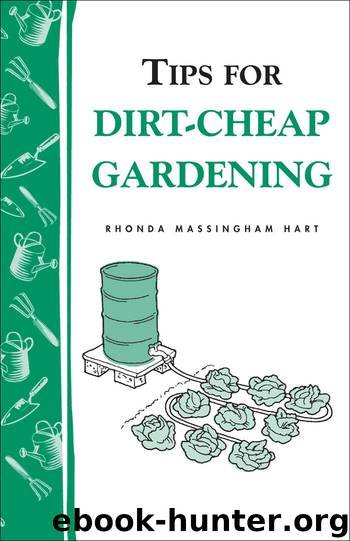Tips for Dirt-Cheap Gardening by Rhonda Massingham Hart

Author:Rhonda Massingham Hart
Language: eng
Format: epub
Publisher: Storey Publishing, LLC
Published: 1996-03-25T16:00:00+00:00
Minimize fertilizer costs by using a carefully timed combination of chemical and organic mixtures.
A common misconception is that synthetic fertilizers are better than organic. Another misunderstanding is that organic is better than synthetic. You can make political or environmental arguments for synthetic or organic fertilizer, but the plants can’t tell the difference as long as the nutrients are available. However, don’t forget the many benefits of adding humus to your soil, which only organic amendments can supply.
Brand labels mean nothing to plants. It’s the fertilizer analysis that counts — the percentage of nitrogen, phosphorus, potassium, and, when present, sulfur in the product, in that order. As mentioned on page 16, these are the major elements plants need (except sulfur, which is a secondary element). Trace elements are also necessary, but manufacturers may or may not list them on labels. Organic fertilizers are much more likely to include these than are chemical formulas.
Plants can only use nutrients that have been reduced to the molecular form. Chemical fertilizers work quickly because they have already been processed into the molecular form, allowing the nutrients to be available at the time of application. Organic fertilizers, on the other hand, must first be broken down by soil microbes and, as a result, release nutrients over a period of time. This activity depends on soil temperature. Below 70°F., soil microorganisms work very slowly, which makes the nutrients in organic fertilizer unavailable to plants in cold soils.
Chemical fertilizers dissolve fairly quickly in water, which makes them easily accessible to plants. Their labels instruct gardeners to water thoroughly after application. Unfortunately, this ready solubility also means that chemical fertilizers, unlike slow-release organics, leach more quickly from the soil.
For the best results with the least expense, strategically combine the two types of fertilizer. In the spring, while the soil is still cool, apply chemical fertilizer to lawn, flower borders, and vegetable gardens. Once the soil is warm, switch to compost or another low-cost organic source.
Mixing your own organic fertilizer costs less and allows you to tailor special compounds for particular plants.
Although the measurable amount of nitrogen, phosphorus, and potassium in synthetic fertilizers usually costs less per pound than those in many commercially prepared organic fertilizers, organic fertilizers are not necessarily more expensive than synthetics. Once you know, roughly, the fertilizer analysis of organic compounds, which varies with different sources, you can mix your own fertilizers, balanced for your particular needs, at a fraction of the cost of a commercially prepared organic fertilizer.
This is where ingenuity and the willingness to scrounge for something pays off. I never buy fertilizer, and you don’t have to either. So long as you supply the plants’ nutrient requirements, it just does not matter to them where the nutrients come from, or whether it is an organic or synthetic source.
You can customize fertilizer to meet your particular needs by comparing the N–P–K requirements of your garden and the N–P–K analysis of various organic fertilizer sources, and then mixing to match.
Determine the pounds of product it
Download
This site does not store any files on its server. We only index and link to content provided by other sites. Please contact the content providers to delete copyright contents if any and email us, we'll remove relevant links or contents immediately.
The Body: A Guide for Occupants by Bill Bryson(4974)
Audition by Ryu Murakami(4850)
Adulting by Kelly Williams Brown(4487)
Housekeeping by Marilynne Robinson(4347)
Be in a Treehouse by Pete Nelson(3948)
Zero Waste Home by Bea Johnson(3780)
Seriously... I'm Kidding by Ellen DeGeneres(3577)
Better Homes and Gardens New Cookbook by Better Homes & Gardens(3525)
The Healing Self by Deepak Chopra(3474)
Barkskins by Annie Proulx(3313)
Hedgerow by John Wright(3276)
The Cellar by Natasha Preston(3262)
Spark Joy by Marie Kondo(3249)
The Genius of Japanese Carpentry by Azby Brown(3226)
The Life-Changing Magic Of Tidying Up- The Japanese Art Of Decluttering And Organizing (v5.0) by Marie Kondo(3215)
120 Days of Sodom by Marquis de Sade(3182)
Work Clean by Dan Charnas(3050)
The Book of Numbers by Peter Bentley(2912)
A Monk's Guide to a Clean House and Mind by Shoukei Matsumoto(2868)
